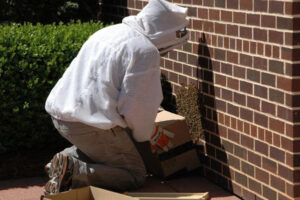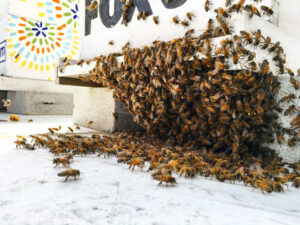 Removing the swarm. After bees from one of the CBC hives decided to mutiny and form their own make-shift hive on the side of the building, a beekeeper comes to restore order and move them back to the ‘real’ hive.
Removing the swarm. After bees from one of the CBC hives decided to mutiny and form their own make-shift hive on the side of the building, a beekeeper comes to restore order and move them back to the ‘real’ hive.
Recently CBC was abuzz with activity, and not because of a breaking news story or peacocks at the station. A swarm of bees from the Hive 5 hives decided to spread out and create their own new home on the side of the building.
We checked in with our resident bee expert, Bee Downtown Founder Leigh-Kathryn Bonner, and find out exactly what happened. What is a swarm and what should you do if you see one?
Every spring in the bee world we have something called “swarm season”. Swarm season usually starts a few weeks after the weather starts to get warm and lasts about 2 months. With the start of the warm weather the queen begins to lay eggs again and hives triple, quadruple, and even quintuple in size (a queen can lay over 1,500 eggs a day!).
Because of the surge in numbers, despite a beekeeper’s best efforts, a hive can decide it wants to become two separate hives. Once a hive decides to do this, it will begin to make new queens (they make multiple at once, but only one of the queens will survive). Even if a beekeeper goes into the hive, sees the new queen cells forming and knocks them down, once a hive has decided it wants to swarm it is almost impossible to change its mind (these ladies are quite stubborn once they’ve decided to do something!).
When a hive swarms, about half of the hive will all leave the hive at once with the old queen (the new queen stays in the original hive). The swarm will then leave and look for a new place to make their home. It takes a swarm about 30-45 minutes to leave the hive, find a spot and land on either a branch or bush (most commonly).
When a hive swarms the bees that leave their hive fill up their honey stomachs with as much honey as they can because they don’t know when the next time they eat will be. Because of this, it makes it very difficult for a bee to sting you because it is so full (think food-baby full) that it can’t bend its abdomen far enough to sting you.
Swarms are also incredibly calm because they are in search of a home. They don’t have an established home yet so they have nothing to defend. While it can be a scary sight to see that many bees flying around all at once, it is also a beautiful sight in nature to see and is something many people don’t ever get to experience.
When a hive swarms it is best to call a beekeeper. PLEASE do not ever spray a swarm of honey bees or do anything to kill the hive if you by chance ever have one land in your yard. A beekeeper will ALWAYS come out to take the hive safely away from your home. Because swarms are so docile, a beekeeper can literally take the bees in their bare hands and place them by the handful into a temporary bee box for them to transport to a new location. You know what they always say…beauty is in the eye of the beeholder.
Last week at CBC our FOX 50 hive swarmed. The FOX 50 hive is the largest hive in the Hive 5 apiary and we were not surprised that it was the first to swarm this spring. The bees were seen flying out on the patio by the gardens and ended up landing (temporarily) on a bush in the grassy area.
 The swarm of bees that landed out in the courtyard and then returned to their hive afterwards.
The swarm of bees that landed out in the courtyard and then returned to their hive afterwards.
When Bee Downtown got to CBC we found a small clump of bees nested in a bush. Tim Grissom, who helps us with the bees, explained there were many, many more bees originally that were flying around then what were now resting on the branch, so we went on a search to find the rest of the hive. It just so happens, after all the hoopla, the hive decided to go back up to the rooftop and settle down underneath the FOX 50 hive.
We brought new hive equipment up to the roof and loaded the, now very famous bees, into their new box and set it up as a new addition to the apiary.
This was the first swarm of the year, but we want to be very honest and open with you, that this will very likely not be the last swarm of the year. This year inparticular has already been a very active year for swarming with hives across the entire state. If we have another swarm at CBC and you feel uncomfortable or are allergic, please stay inside. In about 30-45 minutes the swarm will settle down and we will move them into their temporary box. We also want to share a friendly reminder that there are two very different types of reactions to being stung by a bee, but only one means you are truly allergic to a honey bee.
Localized Reaction: A localized reaction is when you are stung by a honey bee on your hand, for example, and your hand swells, reddens, sometimes slightly swells, and can be itchy over the next few days. This does not mean you are allergic to bees. This simply means you were stung. Every honey bee stinger has venom in it. When a honey bee stings their stinger pulls from their body and will remain in your skin. The venom will enter your body and just like an ant bite, you will feel an uncomfortable prick and your body will have a slight reaction, but you are not at risk for your health (some people actually use apitherapy, purposefully being stung by bees in a specific region of your body, to help reduce the pain from arthritis).
Systemic Reaction: Less than 3% of the adult population is actually allergic to a honey bee sting. A systemic reaction is when you get, for example, stung on your right leg and your left arm begins to swell. A person having a systemic reaction will begin to have trouble breathing and will need to either use an EPIpen they already have, or call an ambulance to come with a pen. Again, this is a very small percent of the population, but there are people that are truly allergic to bees.
We understand that the swarm caused some concern for people in the office, but we want to reiterate that swarms are very calm, and while you will see a lot of bees, they will very quickly settle down and a beekeeper will come to get them. A swarm simply means it is spring and your hives are growing and thriving.
We want to thank everyone at CBC for allowing Bee Downtown to partner with you for this past year and want to remind you that by installing your rooftop hives you are creating true and lasting change in helping rebuild healthy honey bee populations in North Carolina. Studies show honey bees thrive in urban areas, and your healthy and prosperous hives are reinforcing that data.
80% of our food is attributed to a honey bee, but in the last 5 years, the United States alone has lost over ⅓ of its honey bees due to a number of different factors like pesticides, reduced habitat, parasites and a lack of education on how to keep bees.
Because of you commitment to the honey bees and protecting such a precious pollinator, we are able to rebuild healthy, happy, honey bee populations in cities. So on behalf of Bee Downtown and the honey bees, THANK YOU for being such a wonderful partner and community!!!
The CBC swarm. Bees from one of the CBC hives decided to mutiny and form it’s own make-shift hive on the side of the building.
Removing the swarm. After bees from one of the CBC hives decided to mutiny and form their own make-shift hive on the side of the building, a beekeeper comes to restore order and move them back to the ‘real’ hive.
The CBC Hives (l to r): CBC, WRAL-TV, WRAL.com and FOX 50. The hives are located on top of the WRAL-TV studios building at the CBC headquarters on Western Blvd in Raleigh.
The swarm of bees that landed out in the courtyard and then returned to their hive afterwards.
Removing the swarm. After bees from one of the CBC hives decided to mutiny and form their own make-shift hive on the side of the building, a beekeeper comes to restore order and move them back to the ‘real’ hive.
Removing the swarm. After bees from one of the CBC hives decided to mutiny and form their own make-shift hive on the side of the building, a beekeeper comes to restore order and move them back to the ‘real’ hive.
CBC has four hives on the top of the building housing the WRAL-TV studios. (The bees wouldn’t like being on top of the corporate building, where Sky 5 takes off and lands!)
We posted a Capcom story last August, when the bees arrived. Check it out: A Honey of a Friday: Bees Arrive at CBC
Thanks to Leigh Kathryn-Bonner and WRAL-TV for these capcom photos.